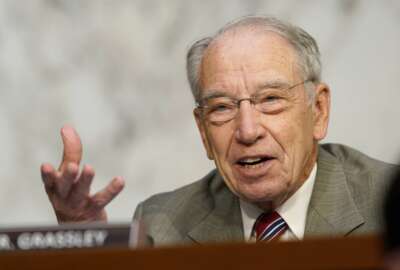Hubbard Radio Washington DC, LLC. All rights reserved. This website is not intended for users located within the European Economic Area.
Support of federal workforce misses mark by a wide margin
Labor groups hoped to see more progress by now. But the administration has failed to live up to expectations about pay, benefits and government service.
wfedstaff | April 17, 2015 4:08 pm
 The Obama administration took office in 2009 with real and perceived campaign promises to support the federal workforce. But federal labor groups said the President has delivered a very different reality.
The Obama administration took office in 2009 with real and perceived campaign promises to support the federal workforce. But federal labor groups said the President has delivered a very different reality.
Several employee labor unions and associations had hoped for more vociferous, strong-willed efforts on behalf of the federal workforce. But instead, they said, an extended civilian employee pay freeze and weak efforts to improve the government’s image have left some employees feeling robbed of support from the White House.
For these and other reasons, Federal News Radio has rated the Obama administration as ineffective in delivering on expectations for support of federal employees. The rating is part of our special week-long multimedia series, The Obama Impact: Evaluating the Last Four Years.
| Why support of federal employees was rated ineffective | |||
| Reason #1: White House releases details on two-year pay freeze for civilian feds
Reason #2: Federal morale deeply impacted by pay freeze Reason #3: New feds’ pension contributions increase (More primary source material available on The Obama Impact performance and morale “I believe that federal employees have paid more than their fair share on the deficit reduction,” said J. David Cox, national president of the American Federation of Government Employees. “Federal employees have been the well that has been repeatedly gone to over and over. And I’m of the opinion that that well is dry. … If the government is going to recruit the best and the brightest and provide great government service, and all these type things, they’re going to have to pay a living wage to be able to recruit and retain good employees.” President Barack Obama has announced his intention to extend the two-year moratorium on civilian employee pay raises while Congress finalizes 2013 spending bills. Not surprisingly, the plan has sparked opposition from federal labor unions. “What I do know is that federal employees have paid over $75 billion [through pay freezes and other efforts to curb government spending],” said Colleen Kelley, national president of the National Treasury Employees Union. “And … federal employees continue to be looked at too often as the piggy bank, a place to find money whenever those who are trying either to fund new programs or current programs. They keep looking to federal employees.”  The administration also has failed to fight back strongly enough in the debate over pay and benefits, said Carol Bonosaro, president of the Senior Executives Association. Some groups, including the Congressional Budget Office, have said federal employees, on average, earn more than private sector workers in similar jobs. Advocates on both sides of the issue have used the data to argue that federal workers earn too much or too little. Pay experts dispute the appropriate mechanism for comparing pay. Different methods yield very different results, but that hasn’t stopped either side from using the data to further their agendas. “An awful lot of misinformation gets tossed around. And, again, I know it’s a tough job, but I think you have to marshal all the facts and present them with some strong emphasis and making the case. And that just-that hasn’t happened,” Bonosaro said of the administration. Making government cool again
Labor leaders also said the President has delivered broken promises in its effort to make government service more attractive, to make it “cool again.” Then candidate-Obama first talked about it during the campaign leading up to his November 2008 election. But his efforts have been plagued by reports indicating the opposite is happening. A recent Pew survey found that 62 percent of Americans in the study have an unfavorable view of government. That number stands in stark contrast to findings from a decade ago, when two-thirds of respondents had a favorable view of government. Patricia Niehaus, president of the Federal Managers Association, said she believes a negative perception of federal employees has caused some lawmakers and political candidates to look for cuts to the federal workforce in the effort to reduce the government deficit. “Federal employees have been unfairly attacked throughout the last four years, and before that somewhat, too,” she said. “We had hoped that this administration would put a stop to that, basically. And it’s gotten worse rather than better.” Various legislative proposals targeting federal pay and benefits have clearly had an impact on employee morale.
In a Federal News Radio survey rating Obama’s performance, more than 70 percent of respondents rated his administration’s support of the federal workforce as “ineffective.” “It was his place to stand up and defend the federal worker and he didn’t do it,” one respondent said. “He allowed Congress to demonize the workforce.” In addition, labor leaders said the administration has failed to support federal employees by agreeing to increase retirement contributions for future employees. The President signed the plan in February as part of a deal to extend a Bush-era payroll tax cut and unemployment benefits. He also included higher contributions as part of the White House’s 2013 budget request. “The federal employee retirement system is fully paid for. That’s not costing taxpayers any money,” Cox said. “Basically, they’re coming to federal employees to take money from them … to offset deficits and things of that nature, not to fund the federal employee retirement system. That’s just wrong.” Not all of the administration’s initiatives regarding federal employees fell flat, however. The White House has worked on improvements for the Senior Executive Service, for example. “One was certainly the effort to adopt a more uniform SES performance management system,” Bonosaro said. The president also managed “to at least get the ball rolling on on-boarding programs for senior executives.” In addition, the administration, as promised, created the National Council on Federal Labor-Management Relations in an attempt to build more trust between employee unions and agency executives. Cox said the White House has “certainly listened to us. They have had some appointments in various agencies that have certainly changed the tide of how those agencies were run, and things of that nature.” More from the special report, The Obama Impact: Evaluating the Last Four Years Part 1: Evaluating the Obama administration’s management initiatives Part 2: Evaluating Obama’s technology reforms Part 3: Evaluating Obama’s workforce initiatives Part 4: Evaluating Obama’s acquisition efforts Part 5A: What would a second-term for President Obama mean for feds? Part 5B: What would a Romney presidency mean for federal workers? Copyright © 2024 Federal News Network. All rights reserved. This website is not intended for users located within the European Economic Area. StateRAMP Exchange 2024: How StateRAMP aims to keep iterating through ‘framework harmonization,’ procurement effortsArmy using ‘sprints’ to find stumbling blocks for AI in acquisition programsTop Stories |




